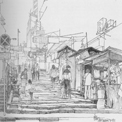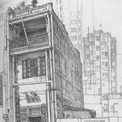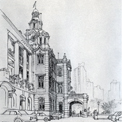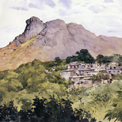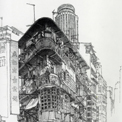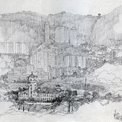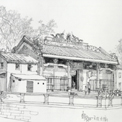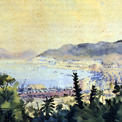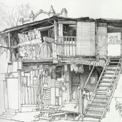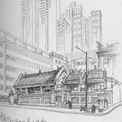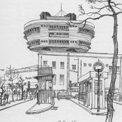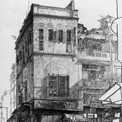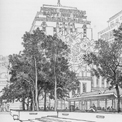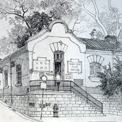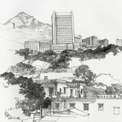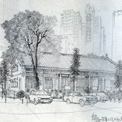Lion Rock
Lion Rock symbolizes the Kowloon peninsula. It is the first thing that catches the travellers' eyes before they land if they come to Hong Kong by air. "Lion Rock" was so named because it resembles a crouching lion. It is one of the mountain ranges that divide the city and the New Territories. "Kowloon" means "nine dragons" in Chinese. The name "Kowloon" was chosen because there are nine peaks (Lion Rock is one of them) lying across the northern part of Kowloon Bay, and the shape of these peaks resemble a dancing dragon. Before Hong Kong became a British colony, local spicy must be transported be to Tsim Sha Tsui Pier through the mountain pass of Lion Rock. There were some farms and households at the foot of Lion Rock. In 1950s and 1960s, it wasd occupited by illeagal-built wooden huts. Nowadays it became blocks of public housing estate.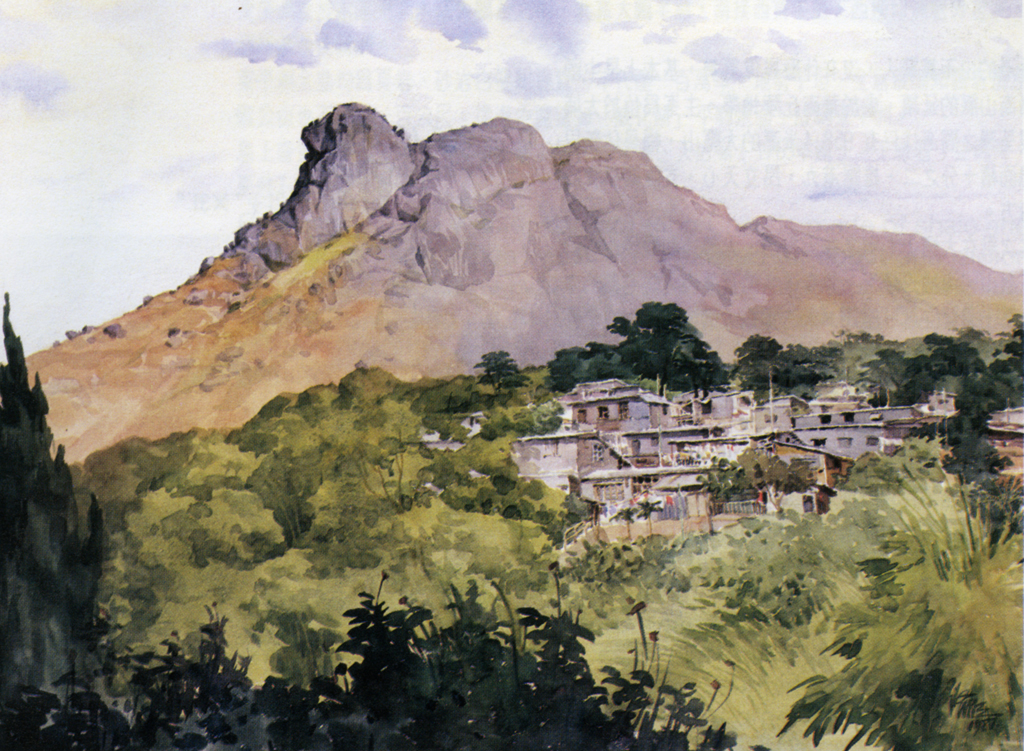
| Date | 1987 |
| Place | Kowloon/Kowloon City District/Kowloon City/Lion Rock |
| people | Kong Kai Ming |
| Material Type | Image |
| Collection | Sketches by Kong Kai-ming |
| Source | Kong, Kai Ming. Landmarks of Hong Kong: Further Artistic Impression. (Hong Kong: The School of Continuing Education, Hong Kong Baptist University, 1994), p.15 |
| Repository | The University of Hong Kong Libraries |
| Note to Copyright | Permission for use is given by Kong Kai Ming |
| Accession No. | LA005-185 |
Lion Rock
Lion Rock symbolizes the Kowloon peninsula. It is the first thing that catches the travellers' eyes before they land if they come to Hong Kong by air. "Lion Rock" was so named because it resembles a crouching lion. It is one of the mountain ranges that divide the city and the New Territories. "Kowloon" means "nine dragons" in Chinese. The name "Kowloon" was chosen because there are nine peaks (Lion Rock is one of them) lying across the northern part of Kowloon Bay, and the shape of these peaks resemble a dancing dragon. Before Hong Kong became a British colony, local spicy must be transported be to Tsim Sha Tsui Pier through the mountain pass of Lion Rock. There were some farms and households at the foot of Lion Rock. In 1950s and 1960s, it wasd occupited by illeagal-built wooden huts. Nowadays it became blocks of public housing estate.
| Date | 1987 |
| Place | Kowloon/Kowloon City District/Kowloon City/Lion Rock |
| People | Kong Kai Ming |
| Material Type | Image |
| Collection | Sketches by Kong Kai-ming |
| Source | Kong, Kai Ming. Landmarks of Hong Kong: Further Artistic Impression. (Hong Kong: The School of Continuing Education, Hong Kong Baptist University, 1994), p.15 |
| Repository | The University of Hong Kong Libraries |
| Note to Copyright | Permission for use is given by Kong Kai Ming |
| Accession No. | LA005-185 |
Lion Rock
Lion Rock symbolizes the Kowloon peninsula. It is the first thing that catches the travellers' eyes before they land if they come to Hong Kong by air. "Lion Rock" was so named because it resembles a crouching lion. It is one of the mountain ranges that divide the city and the New Territories. "Kowloon" means "nine dragons" in Chinese. The name "Kowloon" was chosen because there are nine peaks (Lion Rock is one of them) lying across the northern part of Kowloon Bay, and the shape of these peaks resemble a dancing dragon. Before Hong Kong became a British colony, local spicy must be transported be to Tsim Sha Tsui Pier through the mountain pass of Lion Rock. There were some farms and households at the foot of Lion Rock. In 1950s and 1960s, it wasd occupited by illeagal-built wooden huts. Nowadays it became blocks of public housing estate.
| Date | 1987 |
| Place | Kowloon/Kowloon City District/Kowloon City/Lion Rock |
| People | Kong Kai Ming |
| Material Type | Image |
| Collection | Sketches by Kong Kai-ming |
| Source | Kong, Kai Ming. Landmarks of Hong Kong: Further Artistic Impression. (Hong Kong: The School of Continuing Education, Hong Kong Baptist University, 1994), p.15 |
| Repository | The University of Hong Kong Libraries |
| Note to Copyright | Permission for use is given by Kong Kai Ming |
| Accession No. | LA005-185 |
Lion Rock
Lion Rock symbolizes the Kowloon peninsula. It is the first thing that catches the travellers' eyes before they land if they come to Hong Kong by air. "Lion Rock" was so named because it resembles a crouching lion. It is one of the mountain ranges that divide the city and the New Territories. "Kowloon" means "nine dragons" in Chinese. The name "Kowloon" was chosen because there are nine peaks (Lion Rock is one of them) lying across the northern part of Kowloon Bay, and the shape of these peaks resemble a dancing dragon. Before Hong Kong became a British colony, local spicy must be transported be to Tsim Sha Tsui Pier through the mountain pass of Lion Rock. There were some farms and households at the foot of Lion Rock. In 1950s and 1960s, it wasd occupited by illeagal-built wooden huts. Nowadays it became blocks of public housing estate.
| Date | 1987 |
| Place | Kowloon/Kowloon City District/Kowloon City/Lion Rock |
| People | Kong Kai Ming |
| Material Type | Image |
| Collection | Sketches by Kong Kai-ming |
| Source | Kong, Kai Ming. Landmarks of Hong Kong: Further Artistic Impression. (Hong Kong: The School of Continuing Education, Hong Kong Baptist University, 1994), p.15 |
| Repository | The University of Hong Kong Libraries |
| Note to Copyright | Permission for use is given by Kong Kai Ming |
| Accession No. | LA005-185 |
Lion Rock
Lion Rock symbolizes the Kowloon peninsula. It is the first thing that catches the travellers' eyes before they land if they come to Hong Kong by air. "Lion Rock" was so named because it resembles a crouching lion. It is one of the mountain ranges that divide the city and the New Territories. "Kowloon" means "nine dragons" in Chinese. The name "Kowloon" was chosen because there are nine peaks (Lion Rock is one of them) lying across the northern part of Kowloon Bay, and the shape of these peaks resemble a dancing dragon. Before Hong Kong became a British colony, local spicy must be transported be to Tsim Sha Tsui Pier through the mountain pass of Lion Rock. There were some farms and households at the foot of Lion Rock. In 1950s and 1960s, it wasd occupited by illeagal-built wooden huts. Nowadays it became blocks of public housing estate.
| Date | 1987 |
| People | Kong Kai Ming |
| Material Type | Image |
| Collection | Sketches by Kong Kai-ming |
| Source | Kong, Kai Ming. Landmarks of Hong Kong: Further Artistic Impression. (Hong Kong: The School of Continuing Education, Hong Kong Baptist University, 1994), p.15 |
| Repository | The University of Hong Kong Libraries |
| Note to Copyright | Permission for use is given by Kong Kai Ming |
| Accession No. | LA005-185 |
Lion Rock
Lion Rock symbolizes the Kowloon peninsula. It is the first thing that catches the travellers' eyes before they land if they come to Hong Kong by air. "Lion Rock" was so named because it resembles a crouching lion. It is one of the mountain ranges that divide the city and the New Territories. "Kowloon" means "nine dragons" in Chinese. The name "Kowloon" was chosen because there are nine peaks (Lion Rock is one of them) lying across the northern part of Kowloon Bay, and the shape of these peaks resemble a dancing dragon. Before Hong Kong became a British colony, local spicy must be transported be to Tsim Sha Tsui Pier through the mountain pass of Lion Rock. There were some farms and households at the foot of Lion Rock. In 1950s and 1960s, it wasd occupited by illeagal-built wooden huts. Nowadays it became blocks of public housing estate.
| Date | 1987 |
| Place | Kowloon/Kowloon City District/Kowloon City/Lion Rock |
| People | Kong Kai Ming |
| Material Type | Image |
| Collection | Sketches by Kong Kai-ming |
| Source | Kong, Kai Ming. Landmarks of Hong Kong: Further Artistic Impression. (Hong Kong: The School of Continuing Education, Hong Kong Baptist University, 1994), p.15 |
| Repository | The University of Hong Kong Libraries |
| Note to Copyright | Permission for use is given by Kong Kai Ming |
| Accession No. | LA005-185 |
Lion Rock
Lion Rock symbolizes the Kowloon peninsula. It is the first thing that catches the travellers' eyes before they land if they come to Hong Kong by air. "Lion Rock" was so named because it resembles a crouching lion. It is one of the mountain ranges that divide the city and the New Territories. "Kowloon" means "nine dragons" in Chinese. The name "Kowloon" was chosen because there are nine peaks (Lion Rock is one of them) lying across the northern part of Kowloon Bay, and the shape of these peaks resemble a dancing dragon. Before Hong Kong became a British colony, local spicy must be transported be to Tsim Sha Tsui Pier through the mountain pass of Lion Rock. There were some farms and households at the foot of Lion Rock. In 1950s and 1960s, it wasd occupited by illeagal-built wooden huts. Nowadays it became blocks of public housing estate.
| Date | 1987 |
| Place | Kowloon/Kowloon City District/Kowloon City/Lion Rock |
| People | Kong Kai Ming |
| Material Type | Image |
| Collection | Sketches by Kong Kai-ming |
| Source | Kong, Kai Ming. Landmarks of Hong Kong: Further Artistic Impression. (Hong Kong: The School of Continuing Education, Hong Kong Baptist University, 1994), p.15 |
| Repository | The University of Hong Kong Libraries |
| Note to Copyright | Permission for use is given by Kong Kai Ming |
| Accession No. | LA005-185 |
Lion Rock
Lion Rock symbolizes the Kowloon peninsula. It is the first thing that catches the travellers' eyes before they land if they come to Hong Kong by air. "Lion Rock" was so named because it resembles a crouching lion. It is one of the mountain ranges that divide the city and the New Territories. "Kowloon" means "nine dragons" in Chinese. The name "Kowloon" was chosen because there are nine peaks (Lion Rock is one of them) lying across the northern part of Kowloon Bay, and the shape of these peaks resemble a dancing dragon. Before Hong Kong became a British colony, local spicy must be transported be to Tsim Sha Tsui Pier through the mountain pass of Lion Rock. There were some farms and households at the foot of Lion Rock. In 1950s and 1960s, it wasd occupited by illeagal-built wooden huts. Nowadays it became blocks of public housing estate.
| Date of Death | 1987 |
| Place | Kowloon/Kowloon City District/Kowloon City/Lion Rock |
| People | Kong Kai Ming |
| Material Type | Image |
| Collection | Sketches by Kong Kai-ming |
| Source | Kong, Kai Ming. Landmarks of Hong Kong: Further Artistic Impression. (Hong Kong: The School of Continuing Education, Hong Kong Baptist University, 1994), p.15 |
| Repository | The University of Hong Kong Libraries |
| Note to Copyright | Permission for use is given by Kong Kai Ming |
| Accession No. | LA005-185 |
Lion Rock
Lion Rock symbolizes the Kowloon peninsula. It is the first thing that catches the travellers' eyes before they land if they come to Hong Kong by air. "Lion Rock" was so named because it resembles a crouching lion. It is one of the mountain ranges that divide the city and the New Territories. "Kowloon" means "nine dragons" in Chinese. The name "Kowloon" was chosen because there are nine peaks (Lion Rock is one of them) lying across the northern part of Kowloon Bay, and the shape of these peaks resemble a dancing dragon. Before Hong Kong became a British colony, local spicy must be transported be to Tsim Sha Tsui Pier through the mountain pass of Lion Rock. There were some farms and households at the foot of Lion Rock. In 1950s and 1960s, it wasd occupited by illeagal-built wooden huts. Nowadays it became blocks of public housing estate.
| Date | 1987 |
| Material Type | Image |
| Collection | Sketches by Kong Kai-ming |
| Source | Kong, Kai Ming. Landmarks of Hong Kong: Further Artistic Impression. (Hong Kong: The School of Continuing Education, Hong Kong Baptist University, 1994), p.15 |
| Note to Copyright | Permission for use is given by Kong Kai Ming |
| Accession No. | LA005-185 |
Lion Rock
Lion Rock symbolizes the Kowloon peninsula. It is the first thing that catches the travellers' eyes before they land if they come to Hong Kong by air. "Lion Rock" was so named because it resembles a crouching lion. It is one of the mountain ranges that divide the city and the New Territories. "Kowloon" means "nine dragons" in Chinese. The name "Kowloon" was chosen because there are nine peaks (Lion Rock is one of them) lying across the northern part of Kowloon Bay, and the shape of these peaks resemble a dancing dragon. Before Hong Kong became a British colony, local spicy must be transported be to Tsim Sha Tsui Pier through the mountain pass of Lion Rock. There were some farms and households at the foot of Lion Rock. In 1950s and 1960s, it wasd occupited by illeagal-built wooden huts. Nowadays it became blocks of public housing estate.
| Date | 1987 |
| Material Type | Image |
| Place | Kowloon/Kowloon City District/Kowloon City/Lion Rock |
| People | Kong Kai Ming |
| Collection | Sketches by Kong Kai-ming |
| Source | Kong, Kai Ming. Landmarks of Hong Kong: Further Artistic Impression. (Hong Kong: The School of Continuing Education, Hong Kong Baptist University, 1994), p.15 |
| Repository | The University of Hong Kong Libraries |
| Note to Copyright | Permission for use is given by Kong Kai Ming |
| Accession No. | LA005-185 |
Lion Rock
Lion Rock symbolizes the Kowloon peninsula. It is the first thing that catches the travellers' eyes before they land if they come to Hong Kong by air. "Lion Rock" was so named because it resembles a crouching lion. It is one of the mountain ranges that divide the city and the New Territories. "Kowloon" means "nine dragons" in Chinese. The name "Kowloon" was chosen because there are nine peaks (Lion Rock is one of them) lying across the northern part of Kowloon Bay, and the shape of these peaks resemble a dancing dragon. Before Hong Kong became a British colony, local spicy must be transported be to Tsim Sha Tsui Pier through the mountain pass of Lion Rock. There were some farms and households at the foot of Lion Rock. In 1950s and 1960s, it wasd occupited by illeagal-built wooden huts. Nowadays it became blocks of public housing estate.
| Date | 1987 |
| Place | Kowloon/Kowloon City District/Kowloon City/Lion Rock |
| People | Kong Kai Ming |
| Material Type | Image |
| Collection | Sketches by Kong Kai-ming |
| Source | Kong, Kai Ming. Landmarks of Hong Kong: Further Artistic Impression. (Hong Kong: The School of Continuing Education, Hong Kong Baptist University, 1994), p.15 |
| Repository | The University of Hong Kong Libraries |
| Note to Copyright | Permission for use is given by Kong Kai Ming |
| Accession No. | LA005-185 |
Lion Rock
Lion Rock symbolizes the Kowloon peninsula. It is the first thing that catches the travellers' eyes before they land if they come to Hong Kong by air. "Lion Rock" was so named because it resembles a crouching lion. It is one of the mountain ranges that divide the city and the New Territories. "Kowloon" means "nine dragons" in Chinese. The name "Kowloon" was chosen because there are nine peaks (Lion Rock is one of them) lying across the northern part of Kowloon Bay, and the shape of these peaks resemble a dancing dragon. Before Hong Kong became a British colony, local spicy must be transported be to Tsim Sha Tsui Pier through the mountain pass of Lion Rock. There were some farms and households at the foot of Lion Rock. In 1950s and 1960s, it wasd occupited by illeagal-built wooden huts. Nowadays it became blocks of public housing estate.
| Date | 1987 |
| Place | Kowloon/Kowloon City District/Kowloon City/Lion Rock |
| People | Kong Kai Ming |
| Material Type | Image |
| Collection | Sketches by Kong Kai-ming |
| Source | Kong, Kai Ming. Landmarks of Hong Kong: Further Artistic Impression. (Hong Kong: The School of Continuing Education, Hong Kong Baptist University, 1994), p.15 |
| Repository | The University of Hong Kong Libraries |
| Note to Copyright | Permission for use is given by Kong Kai Ming |
| Accession No. | LA005-185 |
Lion Rock
Lion Rock symbolizes the Kowloon peninsula. It is the first thing that catches the travellers' eyes before they land if they come to Hong Kong by air. "Lion Rock" was so named because it resembles a crouching lion. It is one of the mountain ranges that divide the city and the New Territories. "Kowloon" means "nine dragons" in Chinese. The name "Kowloon" was chosen because there are nine peaks (Lion Rock is one of them) lying across the northern part of Kowloon Bay, and the shape of these peaks resemble a dancing dragon. Before Hong Kong became a British colony, local spicy must be transported be to Tsim Sha Tsui Pier through the mountain pass of Lion Rock. There were some farms and households at the foot of Lion Rock. In 1950s and 1960s, it wasd occupited by illeagal-built wooden huts. Nowadays it became blocks of public housing estate.
| Date | 1987 |
| Place | Kowloon/Kowloon City District/Kowloon City/Lion Rock |
| People | Kong Kai Ming |
| Material Type | Image |
| Collection | Sketches by Kong Kai-ming |
| Source | Kong, Kai Ming. Landmarks of Hong Kong: Further Artistic Impression. (Hong Kong: The School of Continuing Education, Hong Kong Baptist University, 1994), p.15 |
| Repository | The University of Hong Kong Libraries |
| Note to Copyright | Permission for use is given by Kong Kai Ming |
| Accession No. | LA005-185 |
Copyright © 2012 Hong Kong Memory



